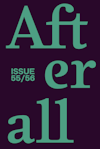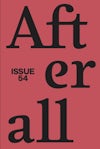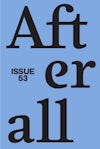
Issue 37
Autumn/Winter 2014
Issue 37 looks at connectivity and the role of the museum in the contemporary age. Artists featured include Boris Charmatz, Juan Downey, Janice Kerbel, the Museum of American Art and Otobong Nkanga. Contextual essays address the representation of identity in post-internet art, the Museum of African Art in Belgrade and the Association for the Advancement of Creative Musicians in Chicago.
Editors: Zachary Cahill, Melissa Gronlund, Anders Kreuger, Pablo Lafuente, Helena Vilalta, Stephanie Smith, Louise O’Hare.
Founding editors: Charles Esche, Mark Lewis.
Table of contents
Foreword
Contextual Essays
- From Narcissism to the Dialogic: Identity in Art after the Internet – Melissa Gronlund
- The Way Ahead: The Association for the Advancement of Creative Musicians and Chicago’s Black Arts Revolution – Dieter Roelstraete
Artists
Juan Downey
- Beyond Technology: Juan Downey’s Whole Earth – Julieta González
- Yanomami, Let’s Talk – Manuela Carneiro da Cunha & Helena Vilalta
Otobong Nkanga
- Exchange and Some Change: The Imaginative Economies of Otobong Nkanga – Monika Szewczyk
- Otobong Nkanga: Nothing Is Like It Seems, Everything Is Evidence – Yvette Mutumba
Museum of American Art
- The Joy of Meta: On the Museum of American Art – Steven ten Thije
- The Doorman – Our Literal Speed
Janice Kerbel
- Janice Kerbel: Diagramming Desire – Anna Lovatt
- Janice Kerbel: Killing the Workers – Tom McDonough
Boris Charmatz
- Boris Charmatz: An Architecture of Attention – Catherine Wood
Events, Works, Exhibitions
- Five Images of an Image: The Museum of African Art in Belgrade – Anders Kreuger
Foreword
Written by Melissa Gronlund
This issue of Afterall is perched, quite literally, between two forms. On the one hand it is a classic Afterall issue, with contributions from many of our favourite and time-honoured writers (Tom McDonough, Dieter Roelstraete, Monika Szewczyk, Catherine Wood) as well as from the editors, and on the other it was put together while a number of the editorial team were in Brazil (Charles Esche, Pablo Lafuente and the former editor Nuria Enguita Mayo) working on the 31st Bienal de São Paulo, which will be on view until early December 2014. The thinking behind the Bienal fed into the journal — as did some of the artists — but as the curatorial process was intended to be organic and responsive, especially to the substantial changes affecting Brazil throughout the Bienal’s preparation, this issue of the journal and the Bienal itself led off into two different directions: the former towards patterns of connectivity and the role of the museum in the contemporary age, and the latter towards discursive and social relations among people.
In many ways the two are interlinked: both shadow the move in contemporary art over the past two decades away from an engagement with the object itself and towards publics, relations and communities. For its part, the Bienal has opted for the nomenclature of ‘participants’ over ‘artists’ and ‘curators’, allowing for the inclusion of other disciplines within the exhibition, and giving a sense of the way the curators work alongside the artists, and of the role that the public, who are also participants, plays in activating and responding to the works on show during the Bienal. The project, in this respect, represents the culmination of thinking at Afterall, particularly by Esche, around the contemporary roles of the museum and the biennial, which sees the museum not as a site for preserving objects but as one that seeks to allow for discourse as a mode of plurality and participation.
This re-thinking of the museum has also been accomplished by the Museum of American Art, included here editorially in the artists’ section of the journal, although the project disputes the definitions of both art and authorship. The Museum reprises key exhibitions that have created the dominant narrative of modern and contemporary art, showing the paintings and sculptures in these exhibitions often as slapdash copies, to further undermine the idea of uniqueness upon which autonomous art is built. As Steven ten Thije and Our Literal Speed suggest, the Museum of American Art points not to the works themselves but to the narratives they create: a recognition of the way in which the context of display influences, if not determines, art’s relationship to its public. Anders Kreuger discusses a real instance of this effect in his essay on the Museum of African Art in Belgrade, which he sees as standing for foreign policy and national aspirations, as much as a space for the exhibition of artistic forms. If the 31st Bienal de São Paulo is questioning existing forms of social organisation and invoking art’s political imagination to conjure new ones, these essays look at the way institutional structures can confine art and make it conservative: se figer, become deliberately stuck. Releasing art’s potentiality is also the project of Otobong Nkanga, who shows the histories that inhere in objects and materials — as well as the performative possibilities that emerge when one takes them off their pedestals or out of their vitrines. From one-to-one conversations between the artist and exhibition visitors to the production of posters distributed in the streets of Lagos, Nkanga has devised forms of communication with her audience that, as Szewczyk and Yvette Mutumba argue, displace the dominant narratives implicit in conventional modes of museological display, as well as the neocolonial assumptions implicit therein.
Purchase
The publication is available for purchase. If you would like specific articles only, it is also available individually and to be downloaded as PDFs.
Purchase full publication
Buy via University of Chicago Press
Buy via Central Books
Purchase individual articles
Buy via University of Chicago Press



